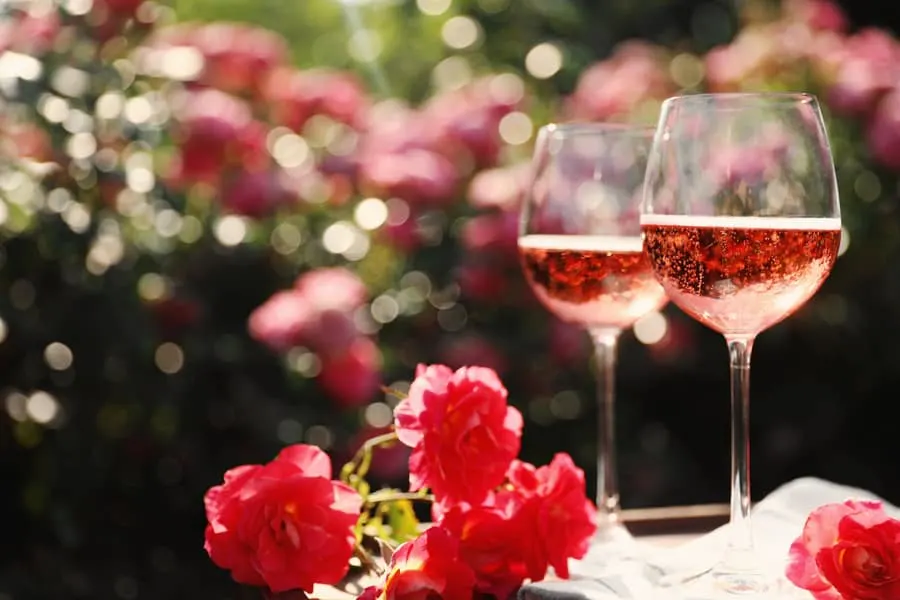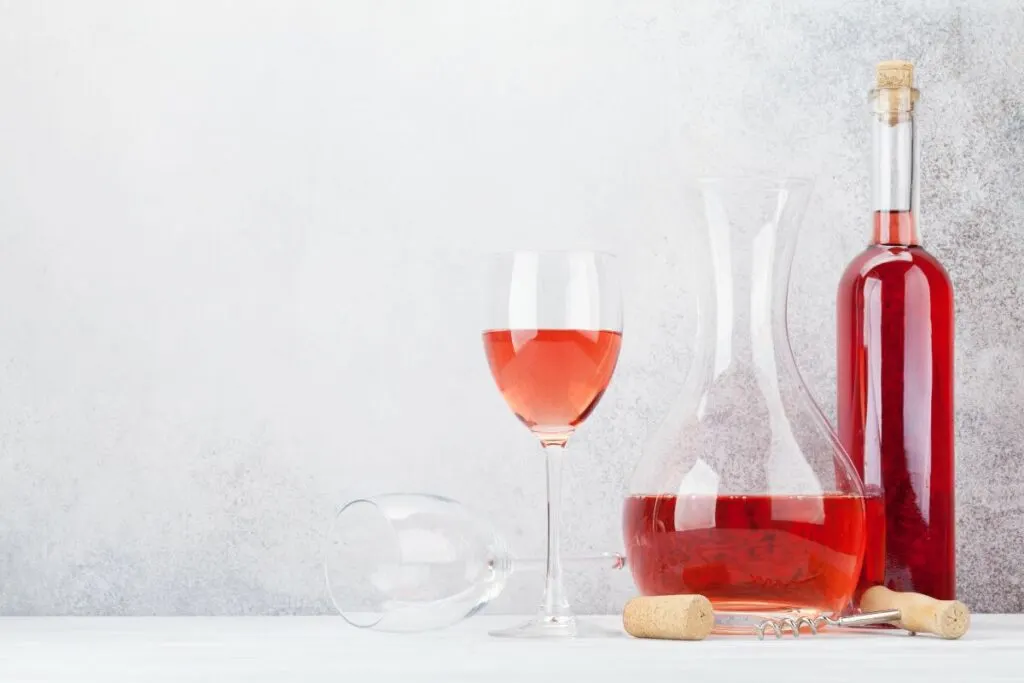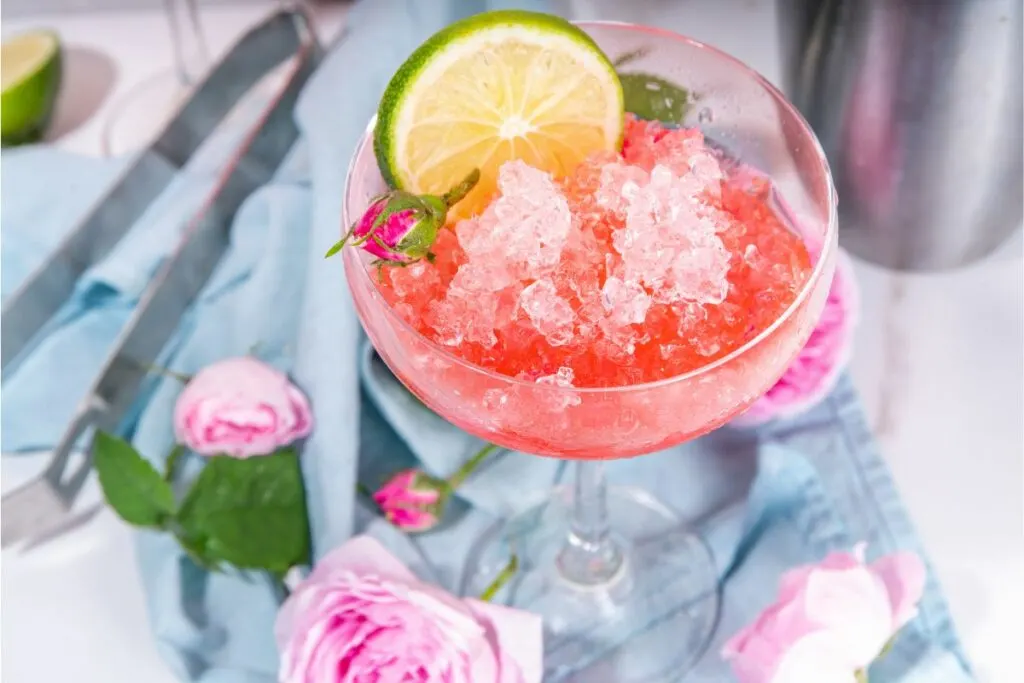As an Amazon Associate, I earn from qualifying purchases with no additional costs for you.
Temperature, Humidity, & Bottle Orientation
55° F is the ideal storage temperature for rosé wine. If that is not achievable, wine stored within a range of 50-60° F should be adequate.
The humidity levels should be as close to 57% as possible. The level will keep the cork moist enough to prevent cracking but not so humid that the cork starts to mold.
If your rosé wine bottles have a cork, you need to lay your bottles flat to keep direct contact with the liquid. However, screw-cap bottles can be stored upright as well.
Recommendation box: Everything you need to enjoy your wine as much as possible. All recommended products are personally tested and regularly used by experts from this website (Amazon links):
> Ivation Wine Cooler – Energy-efficient wine cooler for 18 bottles with Wi-fi smart app control cooling system.
> Wine Rack – Beautiful, elegant wood rack for up to 7 bottles and the choice of vertical or horizontal storage.
> Durand Wine Opener – Classic vintage wine opener (we like all these classic staff).
> YouYah Iceberg Wine Decanter – The most beautiful and handy wine decanter we personally use.
> Bormioli Rocco Wine Glasses – A set of eight elegant and traditional wine glasses made in Italy.
> Vintorio Wine Aerator – Simple but really useful wine aerator for a reasonable price.
> The Original Vacu Vin Wine Saver – The best wine saver on the market in a package with two vacuum stoppers and two wine servers.
And if you want to become a true connoisseur of wine, we recommend reading the book Wine Folly: The Essential Guide to Wine (Amazon link), where you will find all the information you need about winemaking, wine varieties, flavors, and much more.
How Long to Store Rosé
90% of rosé needs to be drunk right away for best results. It is best to drink them within 30 days. Storing rosés was unheard of in the past as rosés have been known as “porch wines”.
Just light wines to be bought and drunk right away. As a rule of thumb, the more recent the vintage, the sooner it should be drunk.
That said, any French rosé, specifically from the Provence region that is one that specifically focuses on producing rosé wine (90% of wines produced here are rosés and are made in oak), will have the ability to age. These oak-aged rosés could potentially age 3-5 years.

TIP: If you want to check out the best refrigerator for wine storage, I recommend trying out the Avation (18 bottles) compressor refrigerator with Wi-fi smart app control cooling system. You can find this refrigerator by clicking here (Amazon link).
Value of Aging Rosé Wine
Almost all white and rosé wines are meant to be drunk when they are young and fresh. I recommend drinking rosé within 1 month of purchase. Anything beyond that and you risk your wine degrading. The more recent the vintage, the sooner it needs to be drunk.
However, intentionally storing wine came into practice in the eighteenth century at the time when glass bottles first came into widespread use.
When aged in a bottle with a tight-fitting cork, some wines largely improved, especially if they were red. These older wines began to bring higher prices than the younger ones. Known as sophisticated, these aged wines began to also appeal to the wine collector.
Most modern wines (white, rosé, or red) are not meant to be aged for long periods of time. Red wines with perfect balance and firm structural characteristics are the only wines that need to be aged for a long period of time. The French have a term for “wines to be saved” – the term is vins de grade.
TIP: Read this article for a complete guide to properly storing red wines and this one for a complete guide on storing white wines correctly.
In a nutshell, 90% of rosés should not be stored for more than 1 month.
3 Things that Matter when Storing Rosé Wine
- A cool environment – the optimum storage temperature is 55° F
- The bottle cannot be standing upright – must be lying on its side (If a bottle is kept on its side, the cork can stay moist with the wine, staying swollen against the neck of the bottle)
- No direct sunlight
TIP: Most wines go bad once you pop the cork within a day or so. But a Coravin Wine Preservation system (available for a great price on Amazon) can extend the life of your opened wine for weeks or even months. It is awesome. You should check it out to see if it fits your lifestyle.
Wine Refrigerator or Kitchen Fridge?
Wine refrigerators are specifically designed to create an optimal environment for wine. This includes a beneficial temperature and the right humidity (around 57%) for the cork to stay moist.
A kitchen refrigerator will be the opposite. It’s always colder than a wine refrigerator and is designed to have zero humidity. In this environment, a cork dries out, begins to shrink, and allows more air to seep into the wine.
TIP: Is there a difference between a wine refrigerator and a wine cooler? This article explains. Find out why wine refrigerators and coolers are so expensive here – this is great information and well worth knowing!
Rosé wine should never be kept in a kitchen refrigerator for more than a month. A kitchen refrigerator isn’t designed to keep a bottle of rose at the optimal temperature. If a kitchen refrigerator is all you have, putting your rosé in it is fine, if you follow a few simple guidelines.
As mentioned above, the maximum amount of time for your rosé to be kept in the refrigerator is one month. Since the wine is going to oxidize gradually over time, any wine with a natural cork will dry out because of a lack of moisture. Once the cork dries out, the oxidation process will begin to move faster.
Keeping a bottle of rosé in the fridge long-term (closer to the month mentioned above) is ok as long as the bottle is equipped with a screw cap or a synthetic cork.
- Rosé Wine with a Screw-Cap Closure: Screw-cap wines used to be thought of by Americans as cheap wine, whereas in Australia and New Zealand they are used for almost all wines! Screw-cap closures are popular with winemakers as a way to eliminate the problem of cork “taint” that is sometimes caused by corks. Twist-offs were at first found most commonly onrosé and white wines where preserving the freshness was a consideration, but are now being used on high-end red wines worth aging. In addition to being the closure of choice in storing your rosé in the refrigerator, they are very easy to open. Some may equate this to the natural cork’s “pop”. Often servers in a restaurant will twist off the cap by rolling it down their forearm for an impressive presentation.
- Rosé wine with a synthetic cork: Just like screw caps, one of the best reasons to use a synthetic cork is to avoid cork taint. Over 90% of rosé wine produced today is meant to be drunk young and not aged, so natural corks are not necessarily needed. Wine experts will tell you that someday the synthetic cork will be able to mimic the breathing and aging process you get from natural cork. But for now, storing your rosé wine in the kitchen refrigerator is best done with a synthetic (or screw cap) cork.
Serving Rosé Wine

White or rosé wines sometimes need aerating – a slang wine term for “breathing”. Most red wines will benefit from this process, however, it’s a personal preference with a rosé.
Decanting a rosé wine is a more complex procedure than aerating a wine. Aerating is simply exposing the wine to air. Oftentimes, decanting is used as a synonym for aerating. Decanting can offer an easy and elegant way of aerating wines when using a decanter made specifically for this purpose.
Decanting a wine means pouring off any sediment at the bottom of a bottle. Sediment is usually present in older red wines (10+ years old). Decanting rosé wine is easy. To decant, pour the wine into a decanter slowly until there are less than two inches of wine left.
In older red wines, for example, you’ll begin to see sediment coming through the neck of the bottle. This is when you should stop! The clear wine will be in the decanter and the sediment left in the bottle. Sediment is not harmful, just not fun to drink. Sediment is something you won’t see in a rosé wine because long-term storage is not recommended.
Decanting can be useful for very old red wines, but also for very young rosé wines to help open up the wine’s flavors and aromas. Decanting accelerates the breathing process. (This is why the terms decant and aerate are used interchangeably).
TIP: If you are interested in buying a wine decanter, I recommend purchasing these two top-quality decanters:
- USBOQO Wine Decanter (check it out on Amazon & read customer reviews)
- Iceberg Wine Decanter (check it out on Amazon & read customer reviews)
It can also soften the taste of the tannins that can cause harshness in young rosé wines. Tannins are defined as a compound found in wine that gives it an astringent, mouth-drying effect.
To aerate wine is to replicate the wine’s natural aging process, making up for the lost years that the wines were bottled up in a wine cellar. Speeding up this process with oxygen exposure is an attractive idea when you’re ready to drink the wine now.
The younger and more tannic the rosé wine, the longer it needs to breathe. An hour is usually enough to soften the tannins but see below for more specifics.
Use a Wide-Bottomed Decanter for rosé

For optimal effect, a wide-bottomed decanter gives maximum air exposure to the wine. This is a wide-bottomed decanter perfect for decanting rosé wine you should consider (Amazon link). Check out the current pricing on Amazon.
It is interesting to note that less dramatic changes can be achieved by removing the cork from the bottle for about 15-60 minutes before pouring. You can also use a large wine glass to pour the rosé in and let it sit for at least ten to twenty minutes.
Reasons Not to Decant
In comparison to red wines, rosé wines are not typically aged in bottles for long periods of time before serving. Because of this, they have little opportunity to develop aromas that need evaporation.
Instead, their natural fruit aromas more specifically define their taste. Because these aromas are volatile, decanting a rosé can sometimes result in a wine with less of an aroma than the winemaker intended.
If you’re leaning towards this train of thought (not aerating), try an experiment for yourself. If your rosé isn’t living up to its aromas and flavors right out of the bottle, grab a decanter and let your wine sit for thirty minutes and try it again.
TIP: Is there a difference between a decanter and a carafe? This article explains all you need to know. How long should you keep your favorite wine in a decanter? Read this article to find out.
You may be pleasantly surprised. The quality a simple decanter and a little patience with the wine can provide will be an experience worth waiting for! Also, learning why you would aerate onerosé while letting another rest without aerating is an important skill to learn.
It’s a skill that will improve your wine-drinking experience and overall wine knowledge as you learn the unique offerings and flavors of rosé. The different styles and types of rosé wines are endless.
As a reminder, don’t let the rosé get too warm while it’s aerating.
Serving Rosé After it has Been Chilled

If you find you’ve already put your rosé in the refrigerator – go ahead and drink it. You can’t take it out, store it at room temperature, and serve it later.
TIP: A suitable wine glass is the basis for enjoying well-being while drinking your favorite wine variety. Here are our favorite ones (Amazon link):
- Bormioli Rocco Crystal Wine Glasses: A set of eight elegant and traditional wine glasses made in Italy for a reasonable price.
- Riedel VINUM Wine Glasses: Luxury set of two wine glasses suitable for any occasion. We just love them!
- Schott Zwiesel Tritan Crystal Glasses: If you like unusual alternatives, a set of six stemless glasses made of crystal glass.
Alternatively, if you take your wine out of a hot pantry or food closet then put it in a cold refrigerator several times because plans have changed – this is detrimental to the wine.
Many people also ask the “wine-in-the-trunk” question. Rosé wine can be left for an hour or less in a hot trunk in the summer heat and still be good. However, several days at hot temperatures will cause the wine to be cooked.
Direct sunlight is harmful to the wine because ultraviolet light results in rapid oxidation in wine. The best wine stores will not display wine in windows. You may see bottles in the windows that are “dummy’ bottles, but that are not meant to be sold.
Does temperature matter when serving rosé wine?
The characteristics of rosé wine are influenced by small differences in a wine’s temperature. A rosé served too warm can taste alcoholic. A rosé wine over-chilled can taste thin.
The general rule that many follow about rosé and white wines is that they should be served chilled. In order to get the rosé and white wines chilled, some put them in the refrigerator and let them chill for hours, days, and oftentimes even longer.
TIP: Check out this page for a complete list of wine products and accessories I love. You’ll find my recommendations for wine refrigerators, decanters, and aerators and the best place to buy wine online. Click here to see the complete listing.
References cited: decanter.com, kj.com, winefolly.com
